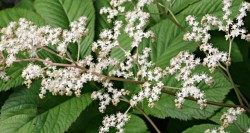Meadowsweet Interactions Overview
Check For Interactions With Meadowsweet
Meadowsweet
- Filipendula ulmaria
- Barbe de Bouc
- Barbe de Chèvre
- Bridewort
- Dolloff
- Dropwort
- Fausse Spirée
- Filipendula
- Filipendule
- Lady of the Meadow
- Mariée de la Prairie
- Meadow Queen
- Meadow-Wart
- Petite Reine
- Queen of the Meadow
 Meadowsweet (Filipendula ulmaria) is a flowering plant native to Europe and Asia, characterized by its feathery white or cream-colored flowers and aromatic fragrance. Historically, Meadowsweet has been recognized for its traditional use in herbal medicine, particularly for its potential to alleviate pain and discomfort due to its natural salicylate content. This plant's pleasant scent and traditional medicinal properties have contributed to its popularity in gardens and as a source of inspiration for herbal remedies.
Meadowsweet (Filipendula ulmaria) is a flowering plant native to Europe and Asia, characterized by its feathery white or cream-colored flowers and aromatic fragrance. Historically, Meadowsweet has been recognized for its traditional use in herbal medicine, particularly for its potential to alleviate pain and discomfort due to its natural salicylate content. This plant's pleasant scent and traditional medicinal properties have contributed to its popularity in gardens and as a source of inspiration for herbal remedies.
Additional Details
Is Meadowsweet Safe? Are There Any Warnings?
Meadowsweet is considered possibly safe when used orally and appropriately in the short-term. Meadowsweet flower has been used with apparent safety at doses of 2.5-3.5 grams daily, while meadowsweet herb has been used with apparent safety at doses of 4-5 grams daily.
However, it is possibly unsafe when used in large amounts or for prolonged periods of time due to its salicylate and tannin content. It is suggested to avoid meadowsweet during pregnancy as it might stimulate uterine activity. There is insufficient information available about the safety of meadowsweet during lactation.
Common Side Effects To Watch For
Meadowsweet seems to be generally well tolerated when used orally. However, there is no high-quality assessment of its safety. Adverse effects reported with meadowsweet include dermatologic reactions, gastrointestinal issues, immune system reactions, ocular or otic reactions, pulmonary or respiratory issues, and renal disturbances.
Effectiveness
There is insufficient reliable evidence to rate the effectiveness of meadowsweet for specific conditions such as headache and respiratory tract infections, including cold, flu, bronchitis, and pneumonia. Further research is needed to determine its effectiveness.
Dosing & Administration
There is no typical dosing information available for meadowsweet. Traditionally, daily doses of 2.5-3.5 grams of meadowsweet flower or 4-5 grams of meadowsweet herb have been used. Liquid extracts and tinctures have also been used with specific dosing recommendations.
Standardization & Formulation
There is insufficient reliable information available about the standardization of meadowsweet.
Interaction Overview
There are a few moderate interaction possibilities with drugs containing salicylates, such as aspirin, choline magnesium trisalicylate, and salsalate. Individuals with allergies or asthma may also need to exercise caution when using meadowsweet due to its potential interaction with aspirin. However, there are no known interactions with supplements.
Pharmacokinetics
There is insufficient reliable information available about the pharmacokinetics of meadowsweet.
Mechanism of Action
Meadowsweet contains various constituents such as tannins, flavonoids (including spiraeoside, isoquercitrin, and rutoside), phenolic acid derivatives, and salicin (a plant salicylate). These constituents contribute to the following observed mechanisms of action:
- Anti-gout effects: Meadowsweet has demonstrated xanthine oxidase activity, primarily due to its glycosylated flavonoid constituent spiraeoside.
- Anti-inflammatory effects: Meadowsweet inhibits inflammation, possibly by inhibiting cyclooxygenase enzyme activities.
- Antimicrobial effects: Meadowsweet has mild urinary antiseptic and antibacterial effects.
- Antiulcerogenic effects: Meadowsweet has antacid activity and is traditionally used for dyspepsia, heartburn, and peptic ulcer disease.
Drugs that interact with Meadowsweet
Return to the main supplement interaction checker page
Parts of this content are provided by the Therapeutic Research Center, LLC.
DISCLAIMER: Currently this does not check for drug-drug interactions. This is not an all-inclusive comprehensive list of potential interactions and is for informational purposes only. Not all interactions are known or well-reported in the scientific literature, and new interactions are continually being reported. Input is needed from a qualified healthcare provider including a pharmacist before starting any therapy. Application of clinical judgment is necessary.
© 2021 Therapeutic Research Center, LLCs